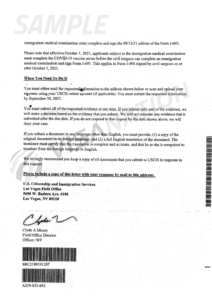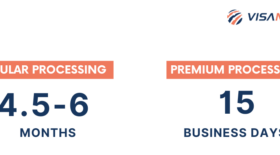Premium processing is a unique service that provides expedited processing for certain work-based petitions. While the usual processing time for most of the USCIS immigration applications takes several months, with the premium processing service, you will receive a decision notice within 15, 30 or 45 business days, depending on your visa type. It is available for various employment-based classification types, including both immigrant and nonimmigrant categories. In this post, we’ll explore premium processing RFE, how the process works, fees, and more.
What Happens After a RFE Response?
RFE Meaning: A request for evidence (RFE) is a common notice from the USCIS indicating that the immigration officer(s) in charge of your application need more information from you before they can proceed with your case.
Every employment-based application has eligibility criteria and other conditions that both the employer and employee must meet. You must provide the necessary documents as proof of qualification along with the application form for the visa category.
These proofs are known as supporting evidence. An RFE gives you the chance to provide documentation that might be missing in your case for officials to make a final decision.
How long does it take USCIS to make a decision after RFE?
If you do not have premium processing, USCIS can take up to sixty days from when they receive the RFE response to contact you (depending on the service center, visa category, case specifics, etc.). However, this timeframe greatly varies case by case. If you look at RFEs issued during the H-1B season, the processing time can be prolonged due to the high number of RFEs issued.
The strategy to shorten the processing time is to select premium processing.
Respond to Your RFE with Confidence
When Is Premium Processing for RFE Beneficial?
Premium processing for an RFE is a good option if your case is time sensitive (you have a fixed job start date, expiring status, etc.) because it guarantees a response in 15, 30 or 45 business days which can prevent gaps in your employment, losing a job offer or worse yet, jeopardizing your visa status. Note that the time frames are measured in business days as opposed to calendar days.
- The cost for premium processing for Form I-129 and Form I-140 is $2,805
- . The cost for H-2B or R-1 nonimmigrant premium processing petitions is $1,685.
Employment-Based Petition Steps
Typically, an employment-based petition, whether on a permanent or temporary basis, requires going through several stages:
- Receive a job offer from a U.S. employer.
- Employer starts with the Department of Labor (DOL) Labor Condition Application (LCA) or PERM application processes.
- File a petition with the United States Citizenship and Immigration Service (USCIS).
- Obtain your visa from the Department of State. If the visa beneficiary is outside the United States, they must undergo consular processing.
For many visas that offer premium processing, it can significantly reduce the waiting period.
Premium processing is not available for every work visa. It can only be used for visas that involve I-129 and I-140 petitions.
- Learn about H-1B RFE reasons and how to respond in this guide!
Sample RFE
Below is a sample RFE full form regarding an I-485, Application to Register Permanent Residence or Adjust Status. You’ll see a section clearly outlined that says, “What You Need to Do,” followed by a section under it that says, “When You Need to Do It.”
It’s important to address all the information USCIS requests in the bullet points so that they can make a decision on your case and submit it by the deadline (information received past the deadline date will not be considered and may lead to a denial on your case).
Submit all the evidence at one time, otherwise, they will make a decision based on the evidence that you submit. Also, include a copy of the RFE letter with your response.


How Does Premium Processing Service Work?
Employment-based petitioners use the premium processing service when they need to expedite the petition’s processing time and cannot or do not want to wait for the usual processing time for the petition.
In a situation where the application needs additional information or there is an intent to deny your petition, you will receive a Request for Evidence (RFE) or notice of intent to deny (NOID) from the USCIS.
If you receive an RFE during the premium processing phase, then it pauses the time window clock. Once USCIS receives the response to the RFE, then the new time frame begins again.
Processing Times Broken Down:
- 15 business days for most Form I-129 and I-140 classifications
- 30 business days for Form I-765 and some Form I-539 applications
- 45 business days for Form I-140 multinational executive and manager; Form I-140 national interest waiver classification
There are a few things to keep in mind when considering premium processing:
- Premium processing does not increase your chances of getting a favorable decision on your petition—it only decreases the amount of time it takes to receive a decision.
- Premium processing can only be used for the I-129 or I-140 petition’s processing time and cannot be used at any other stage. This includes the PERM, LCA, adjustment of status, or consular processing steps.
- When filing for a cap-subject H-1B petition, premium processing does not allow the beneficiary to start working as an H-1B employee until October 1st of the year that the petition is approved (same as applicants who did not opt for premium processing).
- When filing for an employment-based green card, premium processing will only speed up the decision process—you will still need to wait until your priority date is current before moving forward with the green card process.
Upgrading After RFE
You can also choose to upgrade to Premium Processing after receiving an RFE on a case that was originally filed under standard processing. To do this, file Form I-907 (Request for Premium Processing Service) along with your RFE response, or while the RFE response is pending review.
The premium processing clock begins once USCIS receives both the Form I-907 and your RFE response. You can check if your priority date is current with the most recent Visa Bulletin.
Can I Get a Request For Evidence When Using Premium Processing?
Using the premium processing service does not negate the fact that every immigration case must be adjudicated according to the Immigration and Nationality Act (INA). Therefore, if the immigration officer finds your evidence insufficient, whether or not you use premium processing, you will get an RFE or a notice of intent to deny (NOID).
In this scenario, the USCIS will notify the petitioner. If premium processing was used, a new 15-business-day period will begin once the USCIS receives a response to the RFE.
What Does an RFE Contain?
An RFE notice explains why the evidence in your application is considered insufficient and mentions the document(s) you need to include to proceed. The request covers the following areas:
The Immigration National Act
The Immigration and Nationality Act (INA) guides USCIS visa applications and the appropriate evidence for each of them. The relevant law that warrants the RFE will be quoted in the request. This may cover the eligibility requirement(s) that have not yet been met.
The Evidence Submitted
All the documents and supporting evidence you have already submitted will be listed. Take time to read this part carefully to be sure that the USCIS did not miss any of the documents you have already submitted.
The Missing Evidence
The USCIS will specifically state the evidence that is lacking, as well as the reason why the evidence submitted was not sufficient. You will also be given examples of other evidence that may be submitted as alternate options for the missing evidence.
The Deadline
You will be told how long you have to gather and submit the requested evidence. Failure to respond on time will mean the USCIS will make a decision based on the initial evidence with them, which may lead to a denial.
Who is Eligible to File a Request for Premium Processing Service?
Generally, only the petitioners (employers) or their representatives or attorneys are allowed to request premium processing by submitting an I-907. The only exception whereby a visa beneficiary is allowed to make the request is if the employment-based category allows the applicant to self-petition without an employer.
How to File a Premium Processing Request
You can file an I-907, Request for Premium Service, concurrently with your I-129 or I-140 or file separately.
- The I-129 Petition for Nonimmigrant Worker is designated for applicants seeking employment under a temporary status.
- The I-140 Petition for Immigrant Worker, on the other hand, is for those applying for permanent employment-based visas, otherwise known as permanent residence or green card categories.
How to Respond to an RFE
You can prepare and submit your RFE using premium processing. These tips will help with a successful outcome:
Review the Request Carefully
You will need to take the time to carefully go through the premium processing RFE until you are sure that you understand exactly what you are asked to provide. If there is anything you don’t understand, ensure that you ask for help from an immigration attorney or you can contact the USCIS for clarification.
Provide the Evidence All At Once
Typically, an RFE is issued only once, which means you have just one chance to provide a thorough and satisfactory response. Do not ignore any part of the request, no matter how insignificant it might seem, or assume that some items will be overlooked by the USCIS.
Organization is Important
Try to be as concise and thorough in your response as possible. Ensure that the response will be easy to read and understood by the immigration officers. Keep in mind that you must submit the original copy of the RFE along with your new evidence. You can put your response in order by observing the following guidelines when submitting:
- Put the original copy on top of the documents containing your response.
- Include a cover letter or a list of content that itemizes all the new documents in your response.
- Keep a copy of all the new evidence for future reference purposes.
Don’t Procrastinate
Every RFE comes with a deadline, which may be a particular date or a number of days. Make sure you submit the response on or before the deadline. If it is several days, you need to start counting from the date that appears on the RFE (i.e. the date it was issued), which may be earlier than the date you received it.
Know the Different Responses
Any response is better than no response. If you are unable to submit the requested evidence, you can submit a partial response with at least some of the information requested. This may not be favorable, but it does not automatically mean that your petition will be denied. Speak with your immigration attorney before submitting to ensure that you are making the best choice with your RFE response.
Premium Processing Suspension
While premium processing is a very desirable service, it is not always available. The USCIS sometimes suspends the service for certain employment-based categories. This is done to allow other petitions to be processed, especially in visa categories that have an annual cap.
Therefore, it is highly recommended that petitioners first verify whether the premium service is available for the desired classification before filing a request. It is also essential to determine that the visa cap for a category has not been met. As previously mentioned, filing a premium processing does not give special benefits where a cap is applicable.
Is RFE The Same As NOID?
An RFE is different from a NOID. NOID means a Notice of Intent to Deny your application. This is a more negative notice, signifying that the USCIS has already determined that you are not eligible for the classification you applied for. Though a NOID is not an official denial of your petition, it must be treated with more urgent action, as it will most likely lead to denial if you do not provide compelling evidence to salvage the decision. An RFE, on the other hand, simply means that additional information is needed to decide on your case.

It is best to consult an immigration lawyer to help you evaluate your case and see if there is a way it could be salvaged.
You Can Prevent Receiving an RFE
While a premium processing RFE comes as an opportunity to set things right, it is best to prevent it in your immigration application. No matter how you look at it, it is a potential delay to your plans for the new employment. The following tips can help you avoid an RFE:
- Carefully and thoroughly file your initial application, clarifying the job position and description convincingly.
- Present all the relevant supporting evidence to ensure every aspect is covered. For example, you may submit your degree qualification with accompanying transcripts for a visa that has an education requirement.
- Double-check every piece of information and ensure everything is correct and consistent.
- Work with an experienced immigration attorney when gathering, filling out, and submitting your documents.
How We Can Help
The premium processing service is a desirable service that all but guarantees speedy processing of your application. VisaNation Law Group has a team of highly qualified immigration attorneys with a long track record of helping applicants obtain their visas with the premium processing service, even after RFEs.
They will help you prepare your petition and ensure all required documents are included to avoid delays through RFEs. They will also help you prepare your RFE response if you have already received it.




